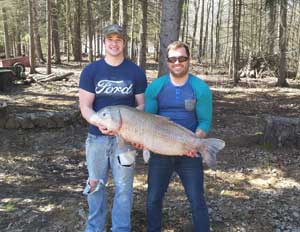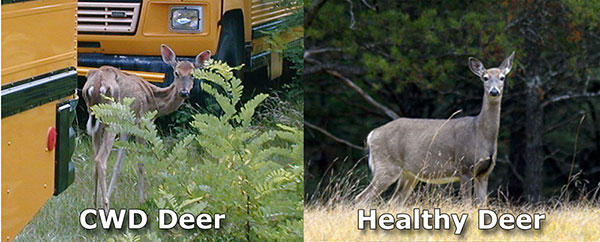- Details
(Provided by Michigan DNR)
The Michigan DNR recently confirmed two new state-record fish for black buffalo and white perch. This marks the second and third state-record fish caught in 2015.
 Sage Colegrove and state record black buffalo.The state record for black buffalo was broken by a fish caught by Sage Colegrove of Muskegon on the Grand River in Ottawa County April 12 while bowfishing. The fish weighed 44.54 pounds and measured 38.50 inches.
Sage Colegrove and state record black buffalo.The state record for black buffalo was broken by a fish caught by Sage Colegrove of Muskegon on the Grand River in Ottawa County April 12 while bowfishing. The fish weighed 44.54 pounds and measured 38.50 inches.
The record was verified by Rich O'Neal, a DNR fisheries biologist in Muskegon.
The previous state-record black buffalo weighed 41.25 pounds and measured 38.25 inches.
- Details
(Provided by Michigan DNR)
The Michigan Natural Resources Commission decided to eliminate the harvest of antlerless deer during the archery season for hunters using deer or deer combo licenses in the Upper Peninsula.
The restriction, which does not affect the firearm deer season, will be in effect for the 2015-2016 season. The NRC made the decision at its monthly meeting in Monroe, Michigan, in an effort to aid the Upper Peninsula's struggling deer population, which has declined to a level comparable to the early 1980s following three successive winters with severe conditions.
There have been roughly 5,000 to 6,300 antlerless deer harvested in the U.P. by archers over each of the past four years.
Although deer regulations currently are on a three-year cycle, elements such as weather and disease can cause regulations to be reviewed mid-cycle and adjusted when appropriate.
- Details
 Michigan confirms states first case of chronic wasting disease in deer
Michigan confirms states first case of chronic wasting disease in deer
The Michigan DNR and Agriculture and Rural Development confirmed that a free-ranging deer in Meridian Township (Ingham County) has tested positive for chronic wasting disease (CWD), a fatal neurological disease that affects white-tailed deer, mule deer, elk and moose.
Ingham County is located southeast of Lansing.
This is the first time the disease has been found in Michigan's free-ranging deer population. In 2008 a white-tailed deer from a privately owned cervid (POC) facility in Kent County tested positive for CWD.
The animal was observed last month wandering around a Meridian Township residence and showing signs of illness. The homeowner contacted the Meridian Township Police Department, who then sent an officer to euthanize the animal. The deer was collected by a DNR wildlife biologist and delivered for initial testing to the DNR Wildlife Disease Laboratory at the Michigan State University Diagnostic Center for Population and Animal Health in Lansing, Michigan. After initial tests were positive, samples were forwarded to the U.S. Department of Agricultureís National Veterinary Services Laboratory in Ames, Iowa, for final confirmation. The Michigan DNR received that positive confirmation last week.
- Details
(Provided by Michigan DNR)
The Michigan DNR will collect eggs from Great Lakes muskellunge in the Detroit River to be reared at the Wolf Lake State Fish Hatchery in Mattawan and stocked in Michigan waters this fall.
Collecting Great Lakes muskellunge eggs began in 2011 in an effort to rear a type of muskellunge that is native to most Michigan waters. In 2014, approximately 430,000 eggs were collected from the Detroit River. Those eggs produced more than 36,000 fish that were stocked in 21 inland lakes and rivers, two of which will serve as broodstock lakes for egg collections in the future.
- Details
(Provided by Michigan DNR)
State game area managers with the Michigan Department of Natural Resources are seeking public input on several draft master plans for state game areas located in the southwestern region of the state.
According to Steve Chadwick, supervisor for the DNR Wildlife Division's southwestern region, these master plans are important in guiding habitat management, based on both the featured species selected for management at each state game area and use of the areas for recreation such as hunting and wildlife viewing.
"In crafting these master plans, we also take into consideration how management of the state game areas affects local economies through activities like timber sales, agricultural production and wildlife-based tourism," said Chadwick.


